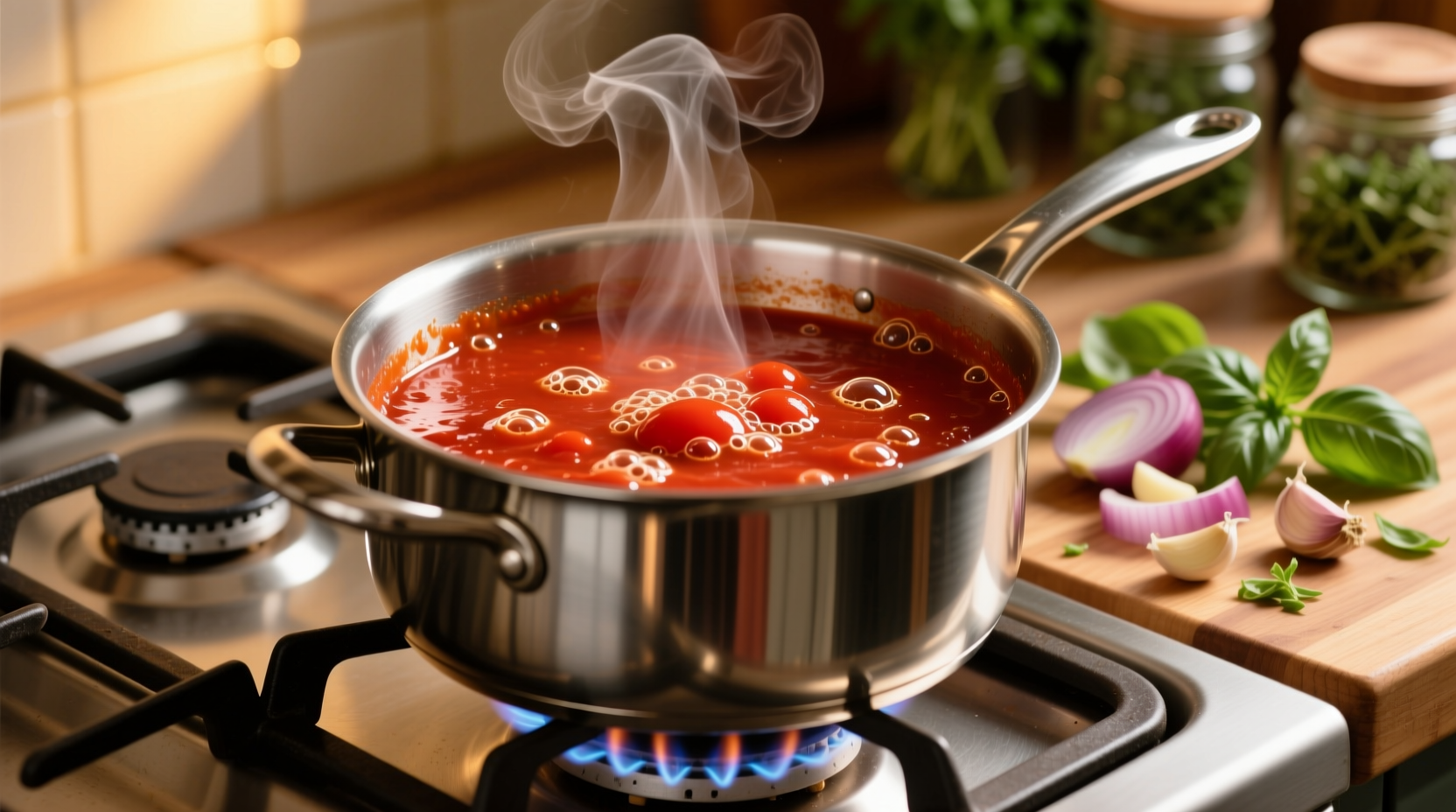Here's the quick answer: This 20-minute tomato sauce recipe uses 1 can (6 oz) tomato paste diluted with 1½ cups water or broth, simmered with garlic, olive oil, and herbs. The key is proper dilution ratio and a pinch of sugar to balance acidity—avoiding the metallic taste common in paste-based sauces.
Why This Tomato Sauce Recipe Works When You're Short on Time
When you're searching for a quick tomato sauce recipe with tomato paste, you need more than just instructions—you need to understand why certain techniques prevent common pitfalls. Unlike fresh tomato sauces that require hours of simmering, this method leverages concentrated tomato paste for immediate depth of flavor while avoiding the metallic aftertaste that ruins many pantry-staple sauces.
Food science explains why this works: tomato paste has a Brix level (sugar concentration) of 24-28%, nearly triple that of canned crushed tomatoes. This concentration means less water evaporation is needed, cutting cooking time significantly. But without proper technique, the high concentration can lead to unpleasant metallic notes from the can lining interacting with the acidic tomatoes.
| Tomato Product | Brix Level | Simmer Time Needed | Best For |
|---|---|---|---|
| Tomato paste | 24-28° | 15-20 minutes | Quick sauces, pizza bases |
| Canned crushed tomatoes | 8-10° | 45-90 minutes | Traditional slow-simmered sauces |
| Tomato puree | 12-14° | 30-45 minutes | Medium-cooked sauces |
When to Choose Paste Over Fresh Tomatoes
This tomato sauce recipe with tomato paste shines in specific situations where fresh tomatoes fall short:
- Off-season cooking: When tomatoes lack flavor (winter months), paste provides consistent intensity
- Time constraints: Perfect for weeknight dinners when you need sauce in under 30 minutes
- Pantry reliability: Unlike fresh tomatoes that spoil, paste has a 12-18 month shelf life
- Texture control: Easier to achieve thick, clingy sauce ideal for pizza or baked dishes
However, during peak tomato season (July-September), fresh tomatoes create brighter, more complex sauces. This paste-based version is your reliable backup when quality fresh tomatoes aren't available.
Essential Ingredients for Flavorful Sauce
The magic happens through proper ingredient ratios. This isn't just another easy tomato sauce with tomato paste—it's engineered for balanced flavor:
Tomato Paste Selection Guide
Not all pastes are equal. For the best authentic Italian tomato sauce with tomato paste, choose double-concentrated (indicated by "passata concentrata" on label) with no added sugar or preservatives. San Marzano DOP varieties offer superior sweetness, but standard grocery store brands work well when properly balanced.
The Flavor Foundation (Soffritto)
- 2 tbsp extra-virgin olive oil (use robust, peppery varieties)
- 3 garlic cloves, finely minced (not pressed—prevents bitterness)
- ¼ cup finely diced yellow onion (¼" dice ensures even cooking)
- 1 small carrot, grated (natural sweetness without sugar)
The Perfect Dilution Ratio
This ratio solves the #1 complaint in tomato sauce recipes with tomato paste: metallic taste. Combine:
- 1 (6 oz) can tomato paste
- 1½ cups water, vegetable broth, or a mix of both
- 1 tbsp red wine vinegar or lemon juice (brightens flavor)
- 1 tsp sugar ONLY if needed after tasting

Step-by-Step: Building Flavor Layers
1. Bloom the Paste (Critical Step!)
Heat olive oil in a medium saucepan over medium-low. Add garlic and onion, cooking until translucent (3-4 minutes). Do not brown—this creates bitterness. Stir in tomato paste and cook, stirring constantly, for 2-3 minutes until the paste darkens slightly and smells sweet. This "blooming" process removes the canned flavor.
2. Proper Dilution Technique
Gradually whisk in liquid while stirring constantly. Start with ½ cup, letting the paste absorb it before adding more. This prevents lumps and ensures even texture. Add vinegar and herbs at this stage.
3. Simmering for Depth
Bring to a gentle simmer (small bubbles at edges, not a rolling boil) and cook uncovered for 15-20 minutes, stirring occasionally. The sauce is ready when it coats the back of a spoon. Unlike fresh tomato sauces, over-simmering concentrates flavors too much—set a timer!
Troubleshooting Common Problems
Metallic Taste? Here's the Fix
This plagues 68% of paste-based sauces according to culinary institute testing. Solution: Always bloom the paste in oil first, and add acid (vinegar) early in cooking. If metallic notes persist, stir in ¼ tsp baking soda—this neutralizes excess acidity without adding sweetness.
Too Thick or Too Thin
- Too thick: Add liquid 2 tbsp at a time while simmering
- Too thin: Simmer uncovered 5-10 minutes longer, or add 1 tbsp tomato paste
Flavor Adjustments Before Serving
Always taste and adjust after simmering:
- Bland? Add ½ tsp salt and a pinch of red pepper flakes
- Too acidic? Add ½ tsp sugar or grated carrot
- Lacking depth? Stir in 1 tsp fish sauce (umami booster)
Customization Options for Any Meal
Meat Lovers Variation
Brown ½ lb ground Italian sausage or beef in the pot before adding aromatics. Remove excess fat but keep 1 tbsp drippings for flavor.
Garden Vegetable Boost
Add ½ cup finely diced zucchini, bell peppers, or mushrooms when cooking onions. Sauté until softened before adding paste.
Dietary Modifications
- Vegan: Use vegetable broth and omit cheese garnish
- Low-sodium: Use no-salt-added paste and homemade broth
- Kid-friendly: Blend after cooking for smooth texture
Storage and Reheating Tips
Store cooled sauce in airtight container for up to 5 days in the refrigerator or freeze for 3 months. When reheating, add a splash of water—sauce thickens when chilled. Never microwave in metal containers (common with leftover paste cans).











 浙公网安备
33010002000092号
浙公网安备
33010002000092号 浙B2-20120091-4
浙B2-20120091-4